As your e-commerce business grows by engulfing more customers into your merchandise, current systems and processes start becoming more dreadful and highly inefficient.
Your staff starts getting overwhelmed by the order volume, and urgent bottlenecks start popping up. Customers start complaining, and you find yourself spending more time putting out fires than growing your business!
Sound familiar?
There are three main ways you can deal with inefficiencies that come from scaling:
- Tire and swamp your current employees to death, wasting their precious time on mechanic tasks contributed to a flawed system.
- Hire new people or freelancers to deal with these boring mechanic tasks, who are expensive to train and keep.
- Automate your e-commerce processes and solve almost all your business problems.
Although this might sound to you like a biased pitch, e-commerce automation is the thing of the future. Once you realize the door of oceanic opportunities it can open, you will feel like your e-commerce business has been jumping in puddles.
How to Use This Guide
- What is e-commerce automation, how does it work, and why everyone from marketers to CEOs is talking about it
- Do you need to automate your e-commerce? [through practical examples]
- 13 different ways you can automate your business for ultimate growth and success
- How to pick an appropriate automation platform [with a specifically curated checklist]
Let’s swim right in!
What is E-Commerce Automation
E-Commerce Automation is a term used to describe any tool or software whose purpose is to help your e-commerce business convert some or all of the manual, repetitive tasks into self-fulfilling, automated tasks.
What are these repetitive, manual tasks your e-commerce employees are getting tired of that we keep talking about?
Some, among many that can be simplified when automated, include:
- Inventory management
- Lead generation
- Strategy and decision making
- Marketing and communication system
- Internal communication
- Customer service
Automating your e-commerce gets rid of intense workload, repetitive tasks and simplifies processes that seem complex or intricate at first glance.
But how exactly does this happen?
In its purest, simplest form, almost all e-commerce automation happens through what we’ll call the TCA (Trigger, Condition, Action). Here’s how it works:
Let’s say you want to automate a very simple task: Any customer that spends over $50 on your website on one order gets free shipping to their delivery address.
The logic behind the automation of this task is the TCA:
- Trigger: The customer creates an order.
- Condition: The customer spends more than $50 on their order.
- Action: The customer gets free shipping.
The simple TCA mechanism works with almost any e-commerce process you wish to automate.
Once you set the trigger, condition, and action, you can say goodbye to pressing additional buttons regarding that process ever again. Instead, you’ll watch it get done flawlessly all by itself.
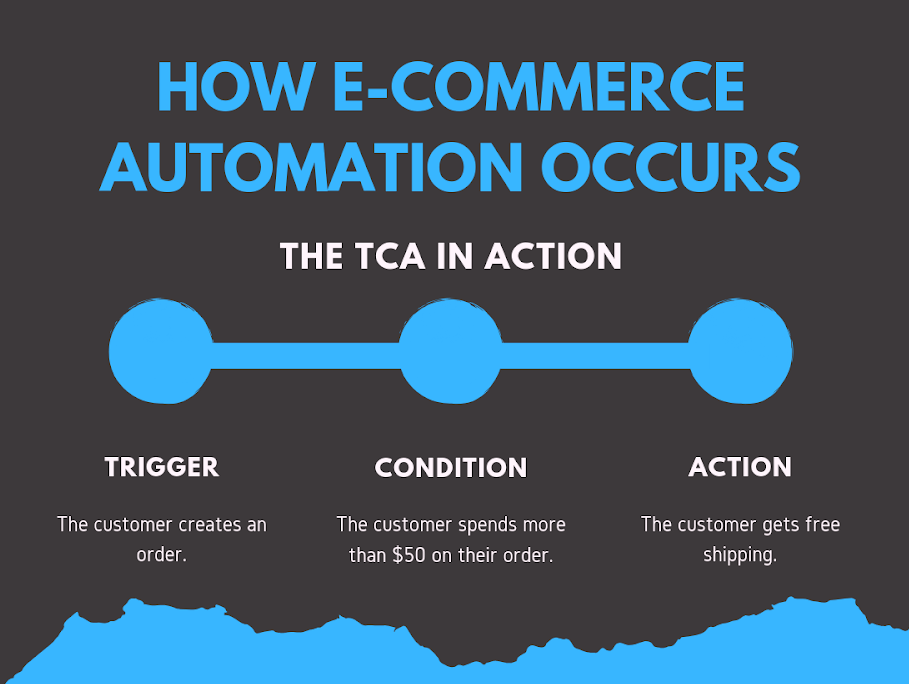
Should You Automate Your Online Store?
The ultimate reasoning behind automating your e-commerce is to amplify the customer experience while simultaneously making time for more important tasks, which require cognitive and interpersonal skills.
However, you’re probably asking yourself whether automating your e-commerce is worth the cost and effort.
We’ll describe some common business scenarios down below. Check all that apply to you.
- Your operational team can’t keep up with the sales volume, because the systems you have in place are inefficient. They express they feel overwhelmed by the work and are feeling demotivated as time goes by.
- Your sales team spends hours getting together and shipping out one order because they have to deal with multiple systems and platforms.
- Moving information from one system to the other takes up around (or more) than one hour per day per employee.
- Your inventory updates are more like down-dates. The inventory briefs are slow, full of mistakes, and you find your store running low on stock due to these inefficiencies.
- Employee and system updates to platforms often lead to lost information or mistakes in crucial data.
- Your sales team is more concentrated in talking to customers to fix order or shipping mistakes than ever.
- Customers are unhappy with your merchandise and are returning their orders because of shipping or process inefficiencies.
If you checked at least four of these problems, then your e-commerce needs automation.
Even if you don’t have any of these problems yet, it is certain that as your business starts growing, you will start experiencing undesirable bottlenecks in your processes.
Better yet, if there are no identifiable flaws in your system, automation will just make everything simpler and more enjoyable for both your employees and your customers.
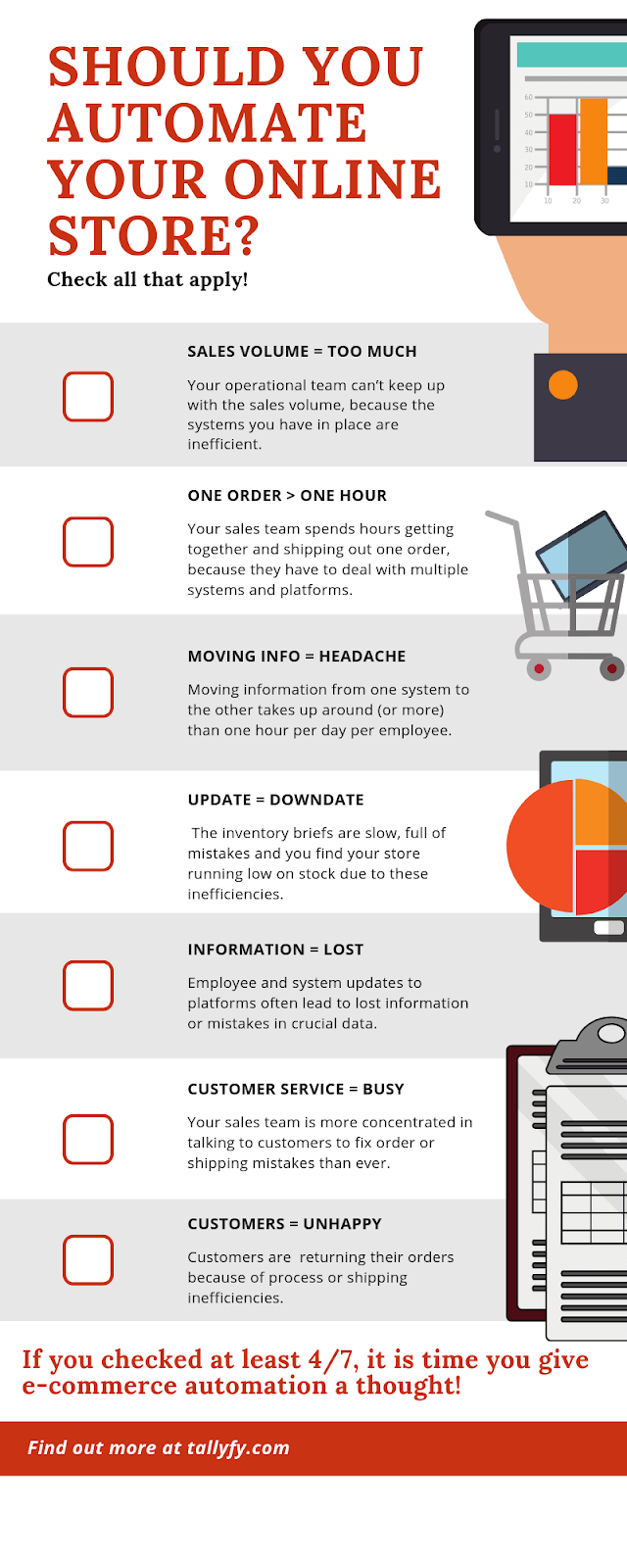
13 E-Commerce Automation Processes
So now that you know you should automate to succeed, where do you begin?
What are the different TCAs you can start using right now to boost your e-commerce into the big leagues through automation?
In this section, we present 13 different e-commerce automation processes made simple. Read through them and take whichever sounds most appealing to you.
Creating Targeted Incentives
Targeted incentives are the number one thing you should be focusing right now.
Customers love to feel valued!
Anything remotely resembling a personal touch will let them know that they are customers of a company which cares about them. Experiential marketing is on the rise precisely because of the need for personalization.
We offer three ways TCA automation can help you customize the customer experience:
- Gift the customer a small token on their birthday. Naturally, you must ask them to enter their day of birth when they create an account. You can give them a one of a kind birthday generated discount code or some free samples. Again, these are just suggestions. You know your customers better than we do!
- Have your customers turn on their geographic location and create relevant promotions to said location. We are talking about national holidays or days of importance for a certain country or U.S. state. For example – Happy National Independence Day, Greece! Get 10% off any order only today by entering the special discount code INDPNDCDAY1. Available only on orders from the Greek territory.
- Offer the option for the customer to see item values in their own currency and to pay in that currency as well. It not only makes the experience more personal but also more convenient. The customer avoids google searches about currency rates and you can earn an extra something from the shadow exchange rate of the item you’re selling.
Personalizing the Customer Experience
Through automation, you can tinker your online store to fit your individual customer needs whilst communicating personalized marketing messages with them.
You can hit these managerial and marketing birds with one stone:
Step 1: Segment your customer base by (1) their purchase history, (2) their buying behavior.
Step 2: Tag each customer in their respective segmentation group.
Step 3: Target each customer segment by email or their preferred contact method with an incentive to create an account. Now they are signed up in the system where you can better track their behavior and set up a customized store for them.
Step 4: Show them relevant products or services and tinker the marketing message to their purchase history and buying behavior segmentation group each time they log in.
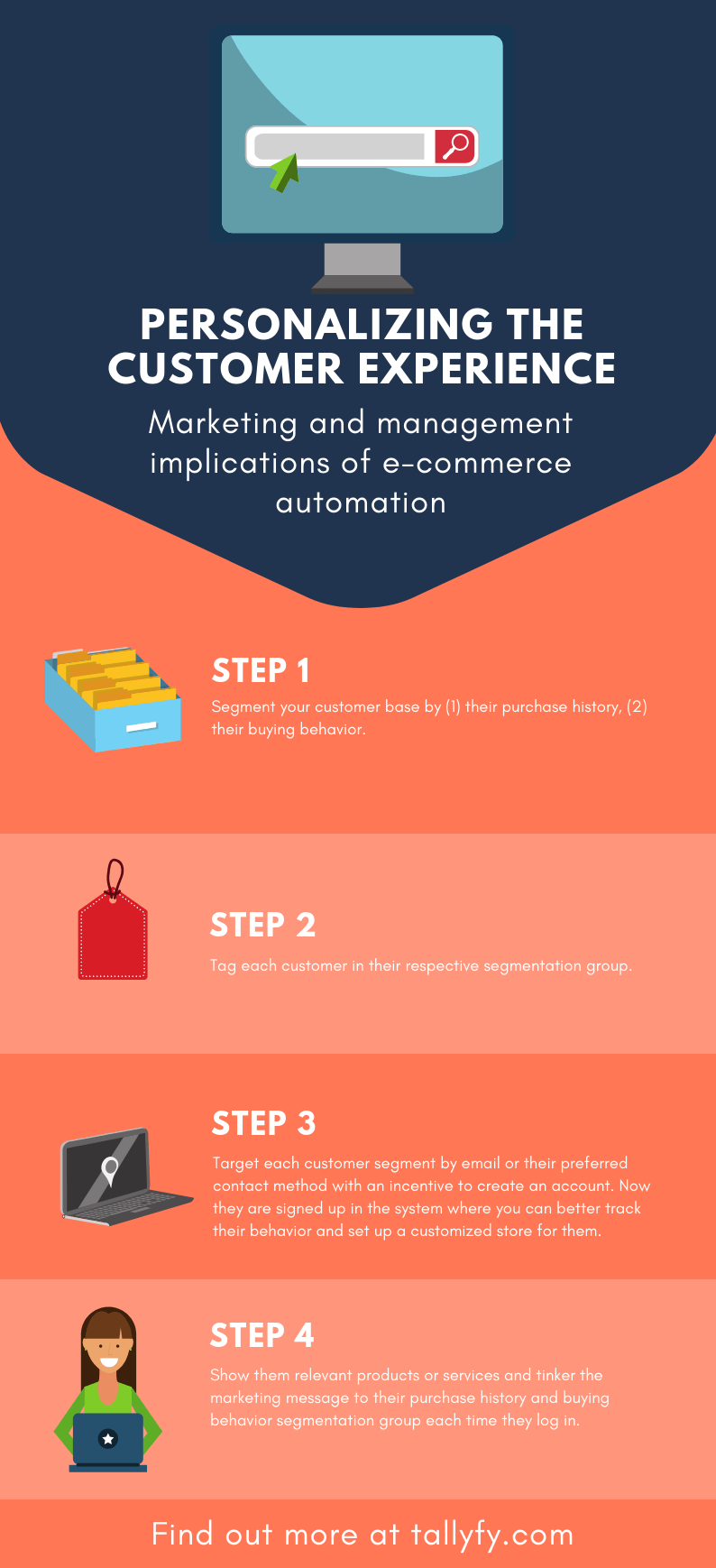
Keeping Inventory in Check in Real Time
Maximizing the efficiency of your inventory is extremely important. You want to avoid stock deficiencies or a case of over-stocking.
Through TCA and e-commerce automation you can, in real time:
Step 1: Tag the inventory system when stock on a particular merchandising item is low or when you are sold out on a certain product.
Step 2: Notify your customers when you’re running low on a certain item and completely hide the product when you run out of it, as to not let down your customers.
Step 3: Ask your customers to actively express if they are interested in buying when the product restocks.
This way of automating your inventory not only makes sure you are stocked at an optimal amount but also helps you predict what the most popular items in your store are.
Keeping inventory in check also helps you determine which products are in high demand so that you keep bringing them back, never leaving your customers unsatisfied.
Responding to Customer Unhappiness
Your customers are your source of revenue, making customer reviews very important. When some of them are unhappy and vocal about it through public comments, other customers are also affected negatively.
You can minimize the impact of customer unhappiness through e-commerce automation:
Step 1: Create a rating system trigger for negative online comments from your customers. We would suggest that anything below or equal to 3 out 5 is a cause for concern. A thumbs down on a product or service would also be categorized here. Take an educated guess based on your own customer feedback system.
Step 2: Whenever there is a negative comment trigger, create a ticket that automatically takes the online comment to be reviewed onto your customer service platform.
Step 3: Assign the ticket to a customer representative to follow through before other customers see it.
Negative comments are given priority through this system. Your staff should aim to respond to any unhappiness as quickly as possible and resolve whatever issue the customer has experienced.
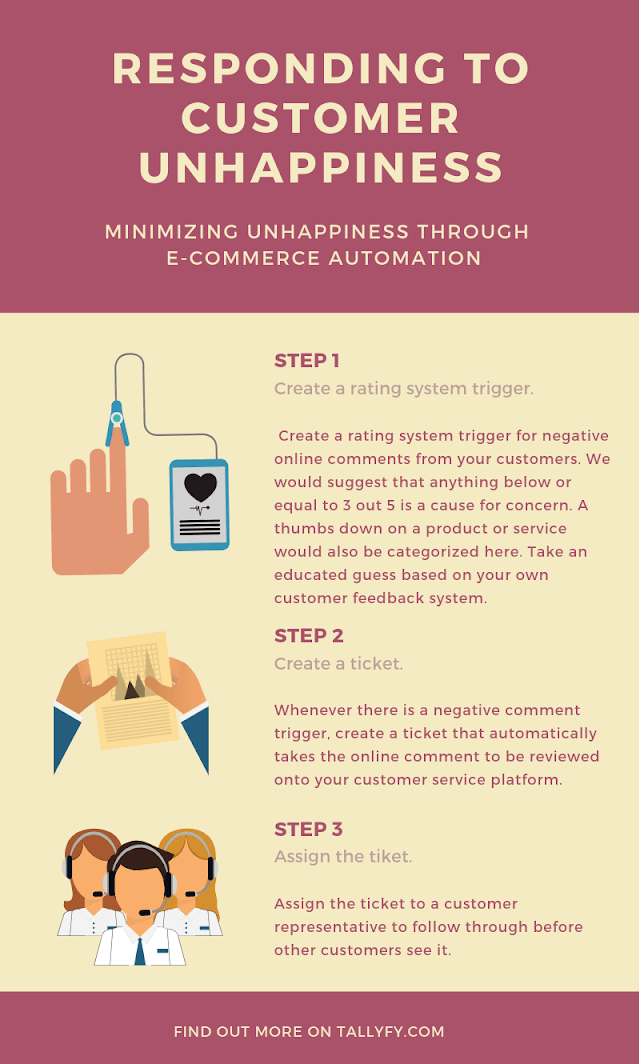
Making ‘Wish Lists’ Matter
For years now, customers have been inserting products on a wish list to check them out later, most of the time forgetting about them.
You can use this to your advantage by giving customers incentives (loyalty points, recommendations) to insert items on their wish-lists.
Send your customers follow-ups on products they like or notifications or emails when there’s a discount for them to purchase. This will not only make your e-commerce website more engaging but will also increase the number of times users are redirected to your site.
Using Discount Codes Smartly
Just like wish lists, discount codes can also come with conditions that amp up customer engagement and satisfaction.
Send discount codes to your customers in emails with special conditions. You can give them free shipping if they increase their purchase value; they can get their third item off if they’re a student etc.
You can employ your creative marketing team to think of more appropriate discount codes, but always remember to create them according to your monthly goals and the individuality of your customers.
Detecting Fraudulent Orders
The TCA system of automating e-commerce can also help you identify and not fall prey to fraudulent orders.
Step 1: Create a tagging system for high-risk orders. Speak to your merchant or finance team to identify tagging characteristics.
Step 2: Forward high-risk orders to Asana, Tallyfy, Trello, or whichever internal system you are currently using.
Step 3: Double-check high-risk orders and mark them as fraudulent in such a case, before they are fulfilled.
Your merchant or respective bank will then be notified and the order will be canceled, letting your team know in real time that it is not going through.
Eliminating risky orders makes your business more efficient and helps your financial situation directly.
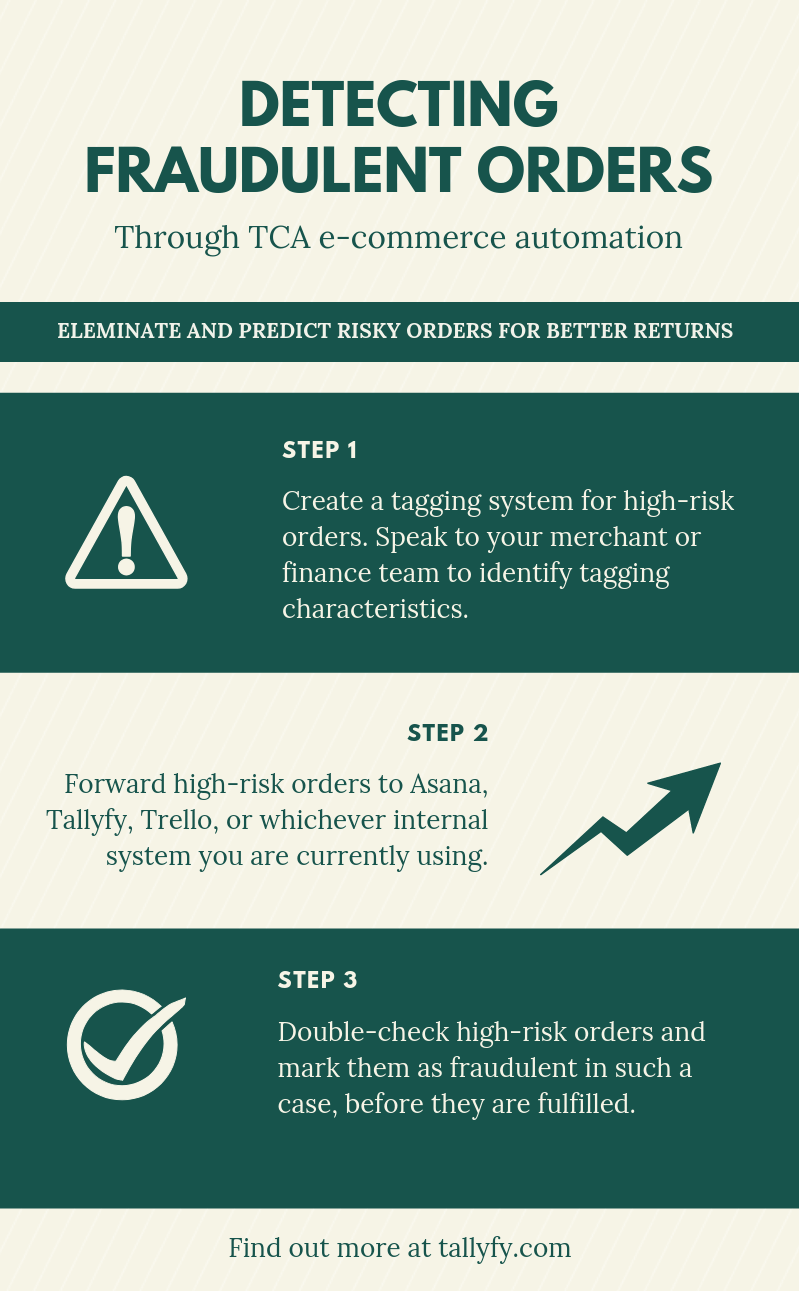
Predicting Customer Demand
There are other ways to predict customer demand except for checking for low-stock inventory. E-commerce automation can help you predict customer demand through search result tracking.
This is fairly straightforward: Track what customers are searching for on your site and they’re getting no results for. Stay one step ahead of the competition by predicting the trend and see what else you can provide that there is a demand for. Watch your revenues and clicks rise!
Boosting Order Value
We have seen so far that people love (1) customization and (2) incentives to purchase.
You can use these two golden insights to boost the average order value for a customer.
Step 1: Create an order threshold for an individual order. This will be based on your own calculations of averages and your e-commerce short-term and long-term order value objectives.
Step 2: Send your customers discount codes, free gifts, loyalty points, a free shipping option, or whichever personal incentive method has proven the most successful.
The purpose of these incentives is to boost the average order value by encouraging your customers to spend more on a particular order, thus raising your AOV and your revenue in the process.
Minimizing customer churn
Customer churn is a term used to refer to the number of customers who stop being your customers.
Although there are many ways to reduce it, a very easy and efficient method has proven to be through e-commerce automation.
As per usual, we will guide you through the logic behind it:
Step 1: Create a list of criteria for customers who you judge are at risk of leaving. Some of the most telling elements can include (1) time since last log-in, or (2) time since last purchase.
Step 2: Identify the customers who are more likely to churn based on the criteria determined.
Step 3: Send these customers one of the incentives discussed previously in this article, like discount codes or promotional prices in an attempt to win them back.
Customer retention is one of the most important metrics in an online business and e-commerce automation helps with the highly important goal of increasing it.
Suggesting Consistent Merchandise
Personal customer tastes are reluctant to change through time and positive previous personal experience is one of the most important indicators that a customer will purchase again.
Well, with e-commerce automation you can now track that and offer each user:
- The possibility of continuous and consistent product discovery
- Suggestions with items that have similar descriptions to those they have browsed
- Continuous updates in their email or preferred contact method when items they have already purchased are restocked or similar items are added to the store.
Customers will be more likely to be attracted to a similar item to the one they purchased if they have had a positive experience with it before.
Allocating Leads
Lead generation is an important part of any online business. Lead management has grown in importance since it is the main way of recruiting customers to your e-commerce.
Automation helps you with leads as well, if you set up the TCA properly.
Step 1: Tag customers orders by sales resource. Before this step, you should have your lead resources divided by categories: Google ads, email, sales personnel effort, etc. This depends on your business’ sales resources.
Step 2: Identify the top performing leads. Look at the statistics that show which leads bring out the most in order terms.
Step 3: Adjust your lead resources accordingly. Invest more in the top performing leads and see your orders enhancing, bringing a large return on investment.
Enhancing Employee Productivity
Last but not least, e-commerce automation leads to enhanced employee productivity.
Although this effect is indirect, by automating certain tasks which take your employees hours to deal with every day, you leave them more space for creative tasks. Subsequently, they will also feel more important and in charge of their own time.
Employees will now make smarter inventory decisions, track demand better to meet customer supply, and have a better foundation for decision-making, all based in data from automation
How To Pick the Best E-Commerce Automation Platform For You
What we have shown you is just a glimpse of what can be done through e-commerce automation. Subscribing to an e-commerce automation platform is your best option to see what else you can automate in accordance with your business model.
With so many automation platforms out there, it can be overwhelming to choose one. However, before you and go and commit to one, there are certain aspects you must keep in mind.
Again, we’re here to help. Here’s what to look for in your e-commerce automation platform:
Pre-built APIs and Connections
The platform must have ready connectors which automatically link your existing platforms to outside parties or existing ones. . You shouldn’t have to spend time or hire outside personnel to navigate the world of TCAs. Instead, the platform should be coding beginner-friendly and allow you to make appropriate decisions. Here is an example from our own API at Tallyfy.
Processing in Real Time
We can’t stress enough the importance of real-time updates to your connected processes. The platform should be equipped with real-time automation, which is highly important for inventory and lead allocation decision making.
Data Validation and Monitoring
Your platform should be able to equip you with the option of double-checking the incoming data. All the information coming in your company must be ensured to be correct, secure, and cleansed. The platform must ensure you with high data quality and security.
Dependable Support Personnel
In case of a potential problem or question, the platform must be able to have 24/7 customer support (you being the customer). The information and support the platform’s team give to you must be real-time and reliable.
These four aspects are essential when you choose your e-commerce automation platform. The more features, of course, the merrier. If the platform offers extra features, you must embrace them and use them to your advantage. However, don’t compromise in these essential four aspects.
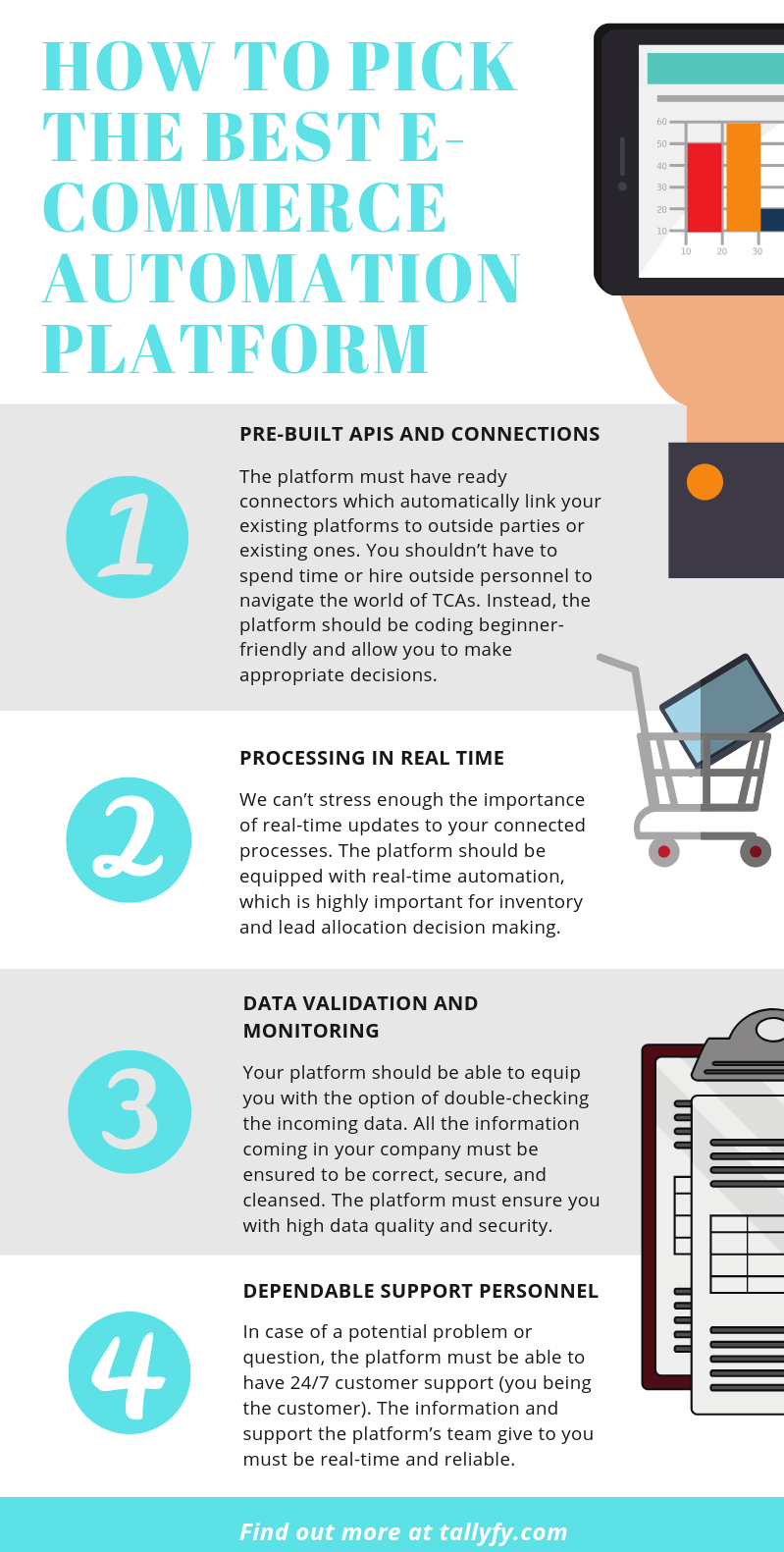
Conclusion
In your e-commerce business, you should strive for an ultimate competitive advantage. Customers are becoming smarter and more demanding, and competitors are growing faster than mushrooms after a rainy day.
To stay ahead of the competition and prepare for the future, you should strive to maximize customer satisfaction while enhancing the productivity of your employees. E-Commerce automation allows you to do both, thus leading to an incredible competitive advantage for your business.
If you are impressed by the benefits that automation gives you and want to find an automation platform that offers you the best features, you should give Tallyfy a try.
Tallyfy is a business process management software that specializes in digitalizing manual processes. You can try the free trial and decide whether it is the best option for your business.
Did you find the information in this article useful? Is there anything else you think we didn’t touch upon? Leave a comment below and tell us what you think.

